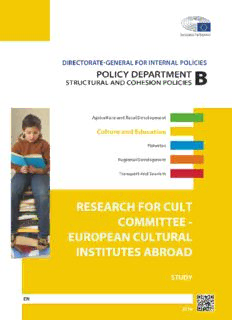
European Cultural Institutes Abroad PDF
Preview European Cultural Institutes Abroad
DIRECTORATE-GENERAL FOR INTERNAL POLICIES POLICY DEPARTMENT B: STRUCTURAL AND COHESION POLICIES CULTURE AND EDUCATION RESEARCH FOR CULT COMMITTEE - EUROPEAN CULTURAL INSTITUTES ABROAD STUDY This document was requested by the European Parliament's Committee on Culture and Education. AUTHORS KEA European Affairs: Yolanda Smits, Clémentine Daubeuf, Philippe Kern RESPONSIBLE ADMINISTRATOR Michaela Franke and Markus J. Prutsch Policy Department B: Structural and Cohesion Policies European Parliament B-1047 Brussels E-mail: [email protected] EDITORIAL ASSISTANCE Jeanette Bell SPECIAL AKNOWLEDGMENTS All organisations and experts participating in our survey (see Annex I). LINGUISTIC VERSIONS Original: EN ABOUT THE PUBLISHER To contact the Policy Department or to subscribe to its monthly newsletter please write to: [email protected] Print ISBN 978-92-823-8493-0 doi:10.2861/767692 QA-04-15-938-EN-C (print) PDF ISBN 978-92-823-8492-3 doi:10.2861/0506 QA-04-15-938-EN-N (PDF) Original manuscript completed in January 2016; 2nd revised edition, March 2016. © European Union, 2016. This document is available on the Internet at: http://www.europarl.europa.eu/supporting-analyses DISCLAIMER The opinions expressed in this document are the sole responsibility of the author and do not necessarily represent the official position of the European Parliament. Reproduction and translation for non-commercial purposes are authorized, provided the source is acknowledged and the publisher is given prior notice and sent a copy. DIRECTORATE-GENERAL FOR INTERNAL POLICIES POLICY DEPARTMENT B: STRUCTURAL AND COHESION POLICIES CULTURE AND EDUCATION RESEARCH FOR CULT COMMITTEE - EUROPEAN CULTURAL INSTITUTES ABROAD STUDY Abstract The objective of the study is to have a better understanding of the role that the national cultural institutes of EU Member States could play in a European strategy for culture in the EU's external relations/cultural diplomacy. It analyses the strengths and weaknesses of their missions, structures and resources. This analysis is aimed at determining whether their activities have a European dimension and whether they would be able to assist the EU in further promoting its priorities and fundamental values in third countries. On the basis of this analysis, the study sets out a number of policy recommendations, including a set of guiding principles for the effective pooling and sharing of resources between the cultural institutes and the EU institutions to achieve scale and thus increase the visibility of EU actions abroad. Furthermore it proposes models of cooperation, incentives and commitments, eligibility criteria for EU-funded projects as well as pilot projects. IP/B/CULT/FWC/2010-001/Lot4/C2/SC2 January 2016 PE 563.418 EN European Cultural Institutes Abroad ____________________________________________________________________________________________ TABLE OF CONTENTS LIST OF ABBREVIATIONS 7 TABLES 9 MAPS AND FIGURES 9 EXECUTIVE SUMMARY 11 1 INTRODUCTION 13 2 CULTURE IN EU EXTERNAL RELATIONS 21 2.1 Recent policy debates and initiatives at EU level 21 2.1.1 Preparatory Action "Culture in EU External Relations" (2013-2014) 21 2.1.2 Council Work Plan for Culture (2015-2018) (November 2014) 22 2.1.3 Joint exchange of views of the AFET and CULT Committees of the EP (March 2015) 22 2.1.4 Conference of the Luxembourg Presidency (September 2015) 23 2.1.5 Conclusions of the Council of Ministers (November 2015) 23 2.2 EU funding for external cultural relations 24 2.3 Cultural diplomacy in the digital age 24 3 STRUCTURE AND ACTIVITIES OF CULTURAL INSTITUTES 27 3.1 Mission and role of cultural institutes 28 3.1.1 Nation branding 28 3.1.2 Cultural cooperation and exchanges 29 3.1.3 Language 29 3.2 Management, structure and budget of CIs 30 3.2.1 Management and structure 30 3.2.2 Budget 31 3.3 Global network and infrastructure 32 3.3.1 Offices Abroad 32 3.3.2 Dates of Establishment 36 3.3.3 Number of Employees 37 3.4 Comparative table and map of the structures of the cultural institutes in the EU 37 3.5 Activities and tools of the European Cultural Institutes and their impact 45 3.5.1 Culture and language activities 45 3.5.2 Thematic and geographical priorities 48 3.5.3 Development of online tools and activities in the digital world 50 4 EUROPEAN DIMENSION OF THE STRUCTURES AND ACTIVITIES OF CULTURAL INSTITUTES 53 4.1 Promotion of the EU and its fundamental values by individual cultural institutes 53 3 Policy Department B: Structural and Cohesion Policies ____________________________________________________________________________________________ 4.2 Collaboration between CIs at EU headquarters level 54 4.2.1 EUNIC Global 54 4.2.2 MORE EUROPE - External Cultural Relations 55 4.2.3 European offices of the CIs in Brussels 55 4.3 Collaboration between CIs in third countries - EUNIC clusters 56 4.4 Participation in EU-funded projects and programmes 58 5 CURRENT AND POTENTIAL ROLE OF CULTURAL INSTITUTES IN THIRD COUNTRIES 61 5.1 Strengths of cultural institutes and their networks 61 5.1.1 EU competence in culture 61 5.1.2 Infrastructure outside the EU 61 5.1.3 Strategic awareness 62 5.1.4 Trusted and credible partners 62 5.1.5 Ties with EU Delegations 63 5.1.6 Internal expertise and experience in (EU) cultural relations projects 64 5.1.7 European networks 64 5.1.8 Alignment with EU strategy for external cultural relations/cultural diplomacy 65 5.1.9 Geographical and thematic priorities 65 5.1.10 Social media 65 5.2 Weaknesses of cultural institutes and their networks 66 5.2.1 Lack of mandate in statutes 66 5.2.2 No common approach/vision on cultural diplomacy/cultural relations 66 5.2.3 Budgetary constraints on the financial, human and technical resources of the CIs 67 5.2.4 Blind spots of representation in third countries 67 5.2.5 Lack of capacity and experience in carrying out EU-funded projects among certain CIs 67 5.2.6 Risk of monopolising EU cultural resources and funds 67 5.2.7 EUNIC is still a young network 68 5.3 Views of other European and national stakeholders 68 5.4 SWOT analysis and summary of conclusions 69 6 RECOMMENDATIONS 73 6.1 Guiding principles 73 6.2 Models of cooperation 73 6.3 Incentives for CIs 74 6.4 Requirements/commitments CIs 75 6.5 Preconditions and eligibility criteria for EU-funded projects 76 6.6 Pilot projects 76 7 REFERENCES 79 4 European Cultural Institutes Abroad ____________________________________________________________________________________________ 8 ANNEXES 85 ANNEX 1: LIST OF STAKEHOLDERS CONSULTED 85 ANNEX 2: QUESTIONS FOR INTERVIEWS WITH CULTURAL INSTITUTES 89 ANNEX 3: QUESTIONS FOR ONLINE SURVEY WITH STAKEHOLDERS 91 ANNEX 4: FACT SHEETS OF 29 SELECTED CULTURAL INSTITUTES 93 Part 1.Eight Cultural Institutes Selected for the Case Studies 93 Part 2. Remaining 21 Cultural Institutes Selected for the Study 104 5 Policy Department B: Structural and Cohesion Policies ____________________________________________________________________________________________ 6
Description: